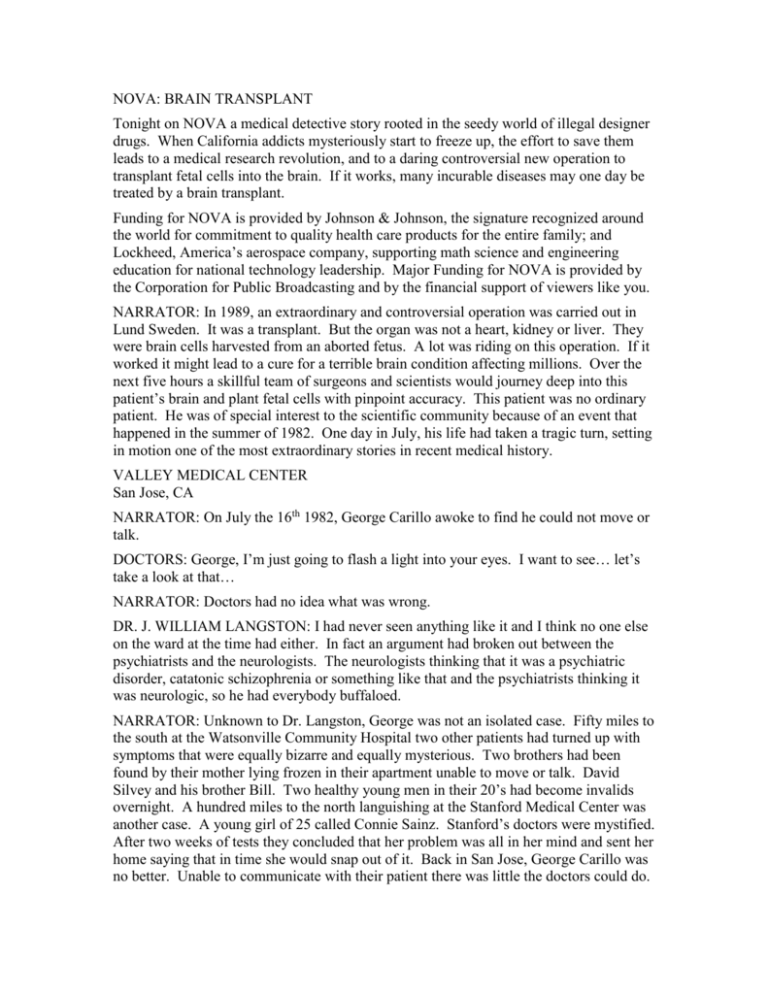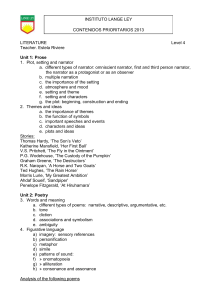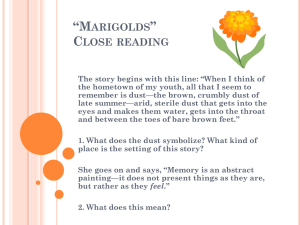
NOVA: BRAIN TRANSPLANT
Tonight on NOVA a medical detective story rooted in the seedy world of illegal designer
drugs. When California addicts mysteriously start to freeze up, the effort to save them
leads to a medical research revolution, and to a daring controversial new operation to
transplant fetal cells into the brain. If it works, many incurable diseases may one day be
treated by a brain transplant.
Funding for NOVA is provided by Johnson & Johnson, the signature recognized around
the world for commitment to quality health care products for the entire family; and
Lockheed, America’s aerospace company, supporting math science and engineering
education for national technology leadership. Major Funding for NOVA is provided by
the Corporation for Public Broadcasting and by the financial support of viewers like you.
NARRATOR: In 1989, an extraordinary and controversial operation was carried out in
Lund Sweden. It was a transplant. But the organ was not a heart, kidney or liver. They
were brain cells harvested from an aborted fetus. A lot was riding on this operation. If it
worked it might lead to a cure for a terrible brain condition affecting millions. Over the
next five hours a skillful team of surgeons and scientists would journey deep into this
patient’s brain and plant fetal cells with pinpoint accuracy. This patient was no ordinary
patient. He was of special interest to the scientific community because of an event that
happened in the summer of 1982. One day in July, his life had taken a tragic turn, setting
in motion one of the most extraordinary stories in recent medical history.
VALLEY MEDICAL CENTER
San Jose, CA
NARRATOR: On July the 16th 1982, George Carillo awoke to find he could not move or
talk.
DOCTORS: George, I’m just going to flash a light into your eyes. I want to see… let’s
take a look at that…
NARRATOR: Doctors had no idea what was wrong.
DR. J. WILLIAM LANGSTON: I had never seen anything like it and I think no one else
on the ward at the time had either. In fact an argument had broken out between the
psychiatrists and the neurologists. The neurologists thinking that it was a psychiatric
disorder, catatonic schizophrenia or something like that and the psychiatrists thinking it
was neurologic, so he had everybody buffaloed.
NARRATOR: Unknown to Dr. Langston, George was not an isolated case. Fifty miles to
the south at the Watsonville Community Hospital two other patients had turned up with
symptoms that were equally bizarre and equally mysterious. Two brothers had been
found by their mother lying frozen in their apartment unable to move or talk. David
Silvey and his brother Bill. Two healthy young men in their 20’s had become invalids
overnight. A hundred miles to the north languishing at the Stanford Medical Center was
another case. A young girl of 25 called Connie Sainz. Stanford’s doctors were mystified.
After two weeks of tests they concluded that her problem was all in her mind and sent her
home saying that in time she would snap out of it. Back in San Jose, George Carillo was
no better. Unable to communicate with their patient there was little the doctors could do.
Then one morning, noticing that he could move his hand very slowly, they had an idea.
They gave him a pencil and asked him to write.
DR. BALLARD: George what we’re going to ask you to do if you can hear us…
NARRATOR: And he could. He wrote the following words: I can’t move right, I know
what I want to do, it just won’t come out right. Astonishingly, inside this frozen body
was a normal mind. By question and answer Langston and Ballard discovered who he
was and what he did. George told them he had a girlfriend who had frozen up as well
called Juanita Lopez. But when they asked what he and Juanita had taken recently in the
way of medicines he gave a strange reply, heroin. George’s clues didn’t make sense
didn’t make sense at first but when Langston and Ballard had heard about the other cases
in Watsonville and Stanford something clicked. The patients had only one thing in
common. George and his girlfriend Juanita, David Silvey and his brother Bill and Connie
Sainz were all drug abusers. They had all recently taken heroin. Soon it was discovered
that Connie’s boyfriend Toby had also frozen up. Langston called a press conference to
warn addicts there was some very dangerous stuff on the streets.
DR. LANGSTON (press conference): Basically it’s a profound slowing of all motor
function, the patients are not able to talk, move, feed themselves, eat. Mentally we think
they’re okay inside.
IN SAN JOSE:
Lloyd LaCuesta (reporter): Dr. Langston says this drug has the characteristic of a burning
sensation when injected. He recommends anyone who thinks they have used that drug
during May or August of last year contact a doctor right away.
NARRATOR: The police gave some of the mysterious heroin to Langston and his
colleagues who began a painstaking analysis of why it was poisoning California’s
addicts. Remarkably it would turn out that the drug was not derived from the opium
poppy nor from any natural product. It was typical of a new type of drug turning up on
the street. Packaged and sold like heroin but made from chemicals in an underground
laboratory, a so called designer drug. Instead of giving a high this chemist concoction
had turn people into statues.
DR. LANGSTON: Can you say your name for me Connie? I think I’ll start by
examining her…
NARRATOR: As Langston cared for his sick addicts, he was struck by the remarkable
similarity of their symptoms to a disease of the elderly called Parkinson’s disease.
Parkinson’s disease usually affects those over 50. It comes on very slowly over a number
of years. Remarkably, the young addicts seem to contract it over night.
DR. LANGSTON: These addicts exhibited virtually every one of the signs that we see in
Parkinson’s disease. And it was pure.
DR. J. WILLIAM LANGSTON
Neurologist-in-chief, Valley Medical Ctr.
DR. LANGSTON: Parkinson’s disease is one of the two most common degenerative
diseases of aging, Alzheimer’s being the other, and this drug mimicked or replicated
virtually all of the symptoms and signs of Parkinson’s disease. At first it’s tremor, the
shaking of an extremity, the rhythmic shaking of an extremity. The second one is a
slowness of movement, movements take much longer to execute. The third is rigidity,
the arms and legs become actually stiff. And this rigidity has an unusual quality to it, it’s
kind of a ratchet or jerky quality, we call it cogwheel rigidity because it kind of snaps.
Almost no other disease does that. After that there’s a large number of symptoms the
most common that most people would recognize is a slow shuffling gait, a short steps,
shuffling with the patient flexed over, bent, this is very characteristic of Parkinson’s
disease. A loss of facial expression and an inability to blink spontaneously which makes
the patient look like they’re staring
NARRATOR: Because of the similarity to Parkinson’s disease Langston decided to start
them on the standard medication, a drug called L-DOPA. No one knew if it would work.
But the effect was miraculous, they came back to life. For the first time in weeks they
had control of their bodies. They could move and they could talk.
CONNIE SAINZ (counting)
NARRATOR: They could tell the world about the nightmare they had experienced.
GEORGE CARILLO: It wasn’t painful, physically. It was painful mentally.
DR. LANGSTON: It was difficult mentally?
GEORGE CARILLO: Yes.
DR. LANGSTON: Was that because you basically loss control or was there fear, or what
types of things were bothering you?
GEORGE CARILLO: Well because of a loss of control, because of fear, because I almost
suffocated.
JUANITA LOPEZ: At the end there I was completely bed ridden; my mom and sisters
had to take care of me. They had to feed me, get me out of bed, take me to the bathroom,
even give me a bath.
NARRATOR: Langston realized he might be on to something big. What had begun as a
drug tragedy might help unravel one of the world’s major brain diseases. L-DOPA
replaces dopamine, a naturally occurring brain chemical without which we would all
freeze up. Without dopamine the thought of lifting an arm can’t be translated into the act
of lifting an arm. If enough of the brain cells that make dopamine die people get
Parkinson’s disease; the characteristic tremor, increasing rigidity, leading eventually to
complete disablement. Langston realized that in the frozen addicts the process was
speeded up hundreds of times. Something in the heroin had passed into the brain and
avoiding every other structure had destroyed just that small area of the brain that makes
dopamine, the substantia nigra. To understand this toxin might be to begin to understand
Parkinson’s disease. By now it was clear what the underground chemist had done. He
had been trying to make a substance called MPPP, chemically quite unlike heroin it
nevertheless produced a heroin like high. Unfortunately, he rushed the synthesis and
instead of making MPPP he made a substance called MPTP as well. This substance
turned out to be deadly. Ironically, the discovery of such a deadly molecule was good
news for millions of sufferers of Parkinson’s disease. Scientists had been hampered in
their efforts to study this disease because only humans get it. To make real progress,
scientists need to study diseases in animals. Now they had a chemical, MPTP, which
could induce parkinsonism in primates. Scientists could systematically study the disease
and try out new treatments. A bizarre drug tragedy had spawned a research revolution.
DR. LANGSTON: After the discovery of MPTP, it was like really a bracing tonic on the
research field, I mean the research field had been in the doldrums for years. Suddenly we
had a new animal model, we had ways to study why cells die in Parkinson’s disease.
With the model we could test new forms of drugs as fast as you could synthesize new
drugs, and there are a wide variety of drugs now that have been tested. So that alone
revolutionized our ability to study new forms drug therapy. Another reason this is of
tremendous scientific interest is that we now have evidence that Parkinson’s is not
predominately an inherited disease. Well if it is not inherited at least predominately it
must be something in the environment that’s triggering it. Well here we have a very
simple toxin, a molecule that from external exposure that can replicate all of the
symptoms of Parkinson’s disease. That spurred tremendous interest in the possibility that
the disease may be due to a chemical in the environment.
NARRATOR: One hotly disputed theory held that pesticides and herbicides might be
responsible, especially after it was discovered that MPTP was transformed in the brain
into a substance with a chemical formula of an herbicide called serbiquot. Langston’s
patients sat on the side lines and watched. Their tragedy had led to a new chapter of
medical research, yet their own problems were far from over.
DR. LANGSTON: I’ve always thought that to the patients it must be a bitter irony that
their disease has, while being so devastating for them, has led to so many research
advances in Parkinson’s disease. I mean it’s kind of like they gave and others have
benefited. All of the patients that got MPTP that we saw originally had severe
parkinsonism, we now know that there are many with mild but the original group was
severe. Their parkinsonism was permanent, it was disabling, and the medications that we
gave them, while they brought some dramatic relief, that proved to be only temporary.
NARRATOR: Within a year or two, most of the patients found that the L-DOPA
produced terrible problems. The huge amounts of L-DOPA they needed to move began
causing too much movement. Movement they couldn’t control. Worse, many of the
addicts began to get terrifying hallucinations.
DR. LANGSTON: Are you having any problem with hallucinations now?
GEORGE CARILLO: Yeah, I’m having them now.
DR. LANGSTON: You’re having them right now. Can you tell me what they’re like?
GEORGE CARILLO: yeah, there real creepy man…like a big snakes coming to get me.
DR. LANGSTON: Like what?
GEORGE CARILLO: A snake’s coming to get me.
DR. LANGSTON: Like a snake’s coming to get you.
GEORGE CARILLO: Yeah, yeah.
DOCTOR: Are you seeing any strange things?
PATIENT (horrified, rubs his eyes)
DR. LANGSTON: The cure is almost worse that the disease. All of our patients with
time developed one or more these side effects. And pretty soon with a number of them,
what we call the therapeutic window, not only got smaller and smaller, but it closed.
Either they were severely off and frozen and miserable or when they turned on, yes they
could move but they these miserable side effects, these twisting turning movements,
terrifying hallucinations. Life in other words was meaningless.
NARRATOR: These six patients had become a central part of Langston’s life and work,
especially Connie.
DR. LANGSTON: And at one point I was really quite concerned that she wasn’t going to
live much longer. She was having trouble eating. She was literally withering away,
wasting and we were all feeling very desperate and bleak about her prospects.
DR. LANGSTON (bringing Connie outside in a wheelchair): Do you like being out in the
sun? Does that feel good?
DR. LANGSTON: With Connie the window was completely closed. She had terrible
side effects with medication. When we took her off the medication she could not move at
all. Inside there she appears to be completely normal. At time you could tell she even
has a sense of humor, as hard as that is to believe.
CONNIE: (smiles at a joke)
DR. LANGSTON: there we go, and I still didn’t get it because it was in Spanish.
NARRATOR: Whereas all the other addicts had been long term drug abusers, Connie
had never taken drugs before 1982. She had paid a terrible price for her mistake.
DR. LANGSTON: Connie has no real meaningful day to day existence. She’s unable to
move, she’s unable to feed herself, she’s unable to bath herself, if she’s depressed she
can’t tell, if she has to go to the bathroom she can’t tell anyone. I can’t imagine it. It
must be worse than being in a prison cell.
NARRATOR: Langston had nothing left to offer any of his patients. The situation
looked desperate. Then something extraordinary happened.
APRIL 2, 1987 (issue of New England Journal of Medicine)
NARRATOR: In April, 1987 an article appeared in the New England Journal of
Medicine describing a daring operation by doctors in New Mexico City. The Mexican
doctors had taken a small group of the patient’s adrenal cells which make dopamine from
their location above the kidney’s and transplanted them into his brain. The dopamine
these cells release gradually reversed the symptoms of Parkinson’s disease, or so the
Mexican team claimed. At a conference in Rochester, an audience watched spell bound
as Dr. Drucker-Colin showed video tape of his patients, both before and after surgery.
DR. DRUCKER-COLIN: Now this is the first patient that you saw, the picture on the
slide. As you can see he has extreme tremor and rigidity. He also have a orthopedic
problem which make his walking also difficult.
NARRATOR: Twelve months later it was a different story.
DR. DRUCKER-COLIN: (video of post-op patient with dramatic improvement)
…January. This is June tenth 1987. This is a little farm that he has in his home. And he
takes care of, he has a little store where he sells groceries and things, which he’s now
capable of doing. This patient was unable to take drugs before and he’s on no drugs now.
Thank you very much.
DR. LANGSTON: And it was a bombshell. The fact that it was in the New England
Journal, the fact that the improvement was so dramatic, literally set the neurologic
community on fire. Could this be the answer, could this be the thing that’s really going
to cure Parkinson’s disease. I think that much of the interest was the fact that it, not to
sound too facetious, but it was simple. You take something out here and put it in there.
That it looked so dramatic, that it could conceivably cure this horrendous degenerative
disease, I think all contributed to this and the word I would use would be stampede.
NARRATOR: Not everybody at the Rochester conference was so enthusiastic. The
Swedish scientist Andres Bjorklund had been working on brain tissue transplants for
twenty years. His team had tried adrenal transplants two years before and they hadn’t
worked at all. Bjorklund had severe doubts about the Mexican work and in the press
conference that followed his Swedish colleague Patrik Brundin was asked by a reporter to
comment.
DR. BRUNDIN: I think one should be cautious and see what the future will tell us, it’s
too early. I’m a bit puzzled and surprised, but I see the same films as you do and it looks
very interesting.
REPORTER: A bit surprised about what?
DR. BRUNDIN: No, no I’m just saying that the rat data wasn’t as encouraging as the
clinical data, but I see the same films, the patient is definitely changed.
DR. RENE DRUCKER COLIN: May I just say one word, I think that in my mind after
doing so many patients, there’s no question that the patients get better. I think the real
question that one has to ask is how long, for how long will they really get better.
NARRATOR: Despite the Swedish skepticism, patients clambered for the operation and
many American surgeons began doing the adrenal transplant procedure that Drs.
Midrozel and Drucker-Colin had championed, but things didn’t go as expected.
DR. LANGSTON: The video tapes were so dramatic that people had been expecting
dramatic results and almost no one was able to replicate those very striking results of
Midrozel and his colleagues in Mexico City. The second problem which was I think
equally important was that the procedure was a complicated one. Taking something out
of the abdomen and putting something into the brain, a craniotomy. That procedure was
pretty heavy surgically, and had a fairly high attended morbidity and even mortality. So I
think the complication rate was unacceptably high.
NARRATOR: For the California patients and their families things looked bleak.
STELLA RODRIQUEZ (Connie’s sister): It’s hard for us because we see how she is.
We hoping why, why weren’t we more stronger with her when she was trying to quit and
everything. Why did it happen and why did all this, you know for something that’s not
even any good if people would only understand that drugs are not good for them because
of look what happens to them and it’s hard because it changes everybody’s lives.
NARRATOR: But the scientific revolution they had begun was moving on. Thousands
of miles away on the island paradise of St. Kitts, Yale university researchers were using
MPTP to do some extraordinary research on monkeys. First, they used this toxin to give
a monkey parkinsonism. Giving it all the usual symptoms, rigidity, tremor and slowness
of movement. Then they set out to cure it, not with adrenal cells but with cells from a
monkey fetus. They dissected out cells from the substantia nigra and implanted them into
the parkinsonian monkey’s brain. Remarkably, the immature fetal brain cells were not
rejected but developed to do what they were designed to do, make dopamine. A monkey
that had been completely frozen was now able to groom its tail. Its parkinsonism had
been reversed. The stakes for this research were very high indeed. If such bran tissue
transplants worked in humans a whole new field of medicine would open up. But to do
this in St. Kitts with monkeys was one thing. To do it on humans in the United States
was quite another.
(protesters with signs chanting)
NARRATOR: Abortion is a subject which arouses strong passions. So much so that
when scientists at the National Institutes of Health asked permission to research fetal
transplants, some people were outraged. A ban was placed on all federal funding until
the subject could be studied by an NIH panel. But when the panel decided that work
should be allowed to go ahead under strict ethical guidelines, the White House kept the
ban in place anyway. Many scientists, many patients and many members of congress
were furious.
REP. HENRY WAXMAN (D) California: I can’t see how members can look people in
the eyes who are suffering from these diseases or who have dear ones, family members
who are suffering, and tell them that it is better to take the fetal tissue that is dead and
burry it rather than let any of that tissue be used for a transplantation that could save
someone’s life.
(protesters chanting: ‘life yes, abortion no’)
NARRATOR: The ban effectively killed off most U.S. research in this area. Scientists
wishing to proceed needed private money and not a little courage. But in the Swedish
town of Lund fetal transplants are not at all controversial. After two decades of basic
research the Lund scientists had concluded that fetal transplants offer the only hope for
curing diseases like Parkinson’s and Alzheimer’s. Back in 1985, before attempting any
human cases, they had asked the Swedish Society of Medicine to initiate a public debate
on the ethics of fetal transplants.
DR. OLLE LINDVALL (Lund Transplant Team): And those discussions were very open
because this is of course is a very serious ethical question. You have to work in a very
responsible way. But on the other hand, these are patients where we have very little to
offer in this stage of the disease and I think that it is, it is a very positive thing to do.
NARRATOR: From this debate came a set of ethical guidelines that most Swedish
people felt comfortable with. A woman’s decision to have an abortion should be kept
completely separate from a surgeon’s decision to perform a fetal transplant. A woman
should not be allowed to direct her fetus to a particular individual, donor and recipient
should remain anonymous, and no money should change hands. With the ethical
guidelines in place, after thirty full rehearsals for the surgery and thousands of animal
experiments, the Swedish team was ready. Two patients with advanced Parkinson’s
disease were prepared for a fetal transplant operation. This time there would be no
videos. Following the surgery the Swedes refused all comment for a year while they did
a series of meticulous tests. But the results were disappointing. The patients were a little
better but nothing like the results obtained in animals. There were many possible
reasons. Perhaps the placing of the graft was wrong. Perhaps they used insufficient fetal
material. But there might be other factors. The transplanted monkeys were young and
healthy. The cause of their parkinsonism, MPTP, was no longer present in their bodies.
Most Parkinson’s patients are old and frail. Their slow degenerative disease probably
remains after surgery and might prevent the immature transplanted cells from growing
properly. Until they knew, the Swedes couldn’t justify many more such operations. In
the midst of these discussions fate took an unusual twist. Andres Bjorklund was invited
to a conference in Belgium. Along with twenty distinguished scientists, he was on route
by bus to the summer palace to a state dinner hosted by princess Lilliana, when the bus
driver took a wrong turn. As the weather worsened the driver pulled into a field to turn
around and got stuck in the mud. As the scientists waited in the dark for help, Andres
began talking to the man next to him, who by coincidence, happened to be Bill Langston.
DR. LANGSTON: And of course we began talking as scientists do about our projects and
the more we talked the more we came to realize that if there was a perfect group of
patients for neural grafting it was the MPTP patients.
NARRATOR: It was a remarkable thought. The California patients might hold the key to
the future of brain tissue transplants. Their pure form of parkinsonism made them of
immense medical importance. They were young. Like the monkeys, the MPTP that had
caused their condition was no longer in their bodies. They did not have a continuing
degenerative disease which might complicate or contaminate the transplanted cells. If
fetal transplants could ever work in humans, it really should work in the MPTP patients.
The Swedes where anxious to assess the possibilities and dispatched Dr. Hakan Widner
to California to see if any of the patients were suitable for surgery. Widner found
California a strange and exotic land. He had never encountered patients like these. Of
the original six cases, three had returned to a life of crime they had pursued before their
tragedy and were residing in Vockaville Jail in northern California.
DR. HAKAN WIDNER (Lund Transplant Team): It was quite an adventure, quite an
experience. It was David Silvey there, who was very keen on advocating an operation for
his brother Bill. Unfortunately, Bill was severely over medicated and had severe
problems with hallucinations. For practical terms we had to get him out of jail which I,
we actually considered calling up his parole officer and tried to get him out of jail and
started to look into companionate reasons for premature release and so on, but we gave
up pretty soon.
NARRATOR: That left David Silvey himself and Toby Govia, but as candidates for a
scientific research project they were not ideal.
DR. LANGSTON: These patients got MPTP because they were drug abusers and of
course many of them supported their habit through crime and, I mean this is no secret.
When you have parkinsonism and some of the side effects of therapy that I was talking
about you can have real problems being a criminal. One of our patients burglarized a
house. Well I guess he set off some kind of alarm or something and he rushed out of the
house in the backyard to make his escape. Started to climb over the fence and went into
one of these freezing spells that we talk about, his medication turned off and he just froze
as he was climbing over the fence. So apparently when the police arrived here was the
burglar in the backyard just like a statue, waiting for them. They said it was the easiest
apprehension they ever made. They just had to pick him up and carry him off the poor
guy. So he was in jail, so a number were in jail and in fact still are. As it turned out none
of the three candidates in jail were selected.
NARRATOR: David, Bill and Toby were out of the running. Three patients were left, all
anxious to go.
DR. LANGSTON: Juanita, it’s good to see you again after 3 or 4 years. I’m glad you
could come down. You understand the purpose of all this is that you’re being considered
as possibly a candidate to go for transplantation to try to cure the parkinsonism that
you’ve had from MPTP for a long time.
NARRATOR: Juanita was in terrible shape. Without medication she froze yet with it she
could not control her movements at all. Her life was a living hell. The operation in
Sweden was all she had to look forward to. For George the hallucinations were his worst
symptom. Every day for eight years he had seen snakes and fire coming at him.
(George struggling as if to push away something with Dr. Widner by his side)
DR. WIDNER: What’s happening? What’s happening? All right?
GEORGE: All right.
NARRATOR: And yet without L-DOPA George turned to stone.
DR. WIDNER: He is encased within his own body. And he has a clear mind and wants
to get out of it when he’s off, when he can’t move. He can perform any movement in his
mind but he can’t make his muscles do this, and it’s horribly painful for him actually
being in that situation. While walking he can suddenly freeze up and cannot walk any
further. That is also very typical of Parkinson’s. One can overcome that by asking him
to lift his foot or step over a line or some obstacle and then he can get going again. No
one knows. It’s very strange. The mechanism on how the gait is generated, sort of the
software, the programming in the brain is not known but it must be two different systems
here and one gets fatigued and do something, and run out of gas and he can switch to
another program and use that for a while.
DR. LANGSTON: Hello. Here’s someone I like you to meet. This is Dr. Widner from
Sweden and we’ve come down to see Connie. Can you say hello, can you try to say hello
for us? (Connie tries to speak). Oh my gosh, you did. This is Dr. Widner, Hakan
Widner, he’s come to see you from Sweden.
DR WIDNER: Nice to meet you.
DR. LANGSTON: And he’s one of the members of the transplant team that we’ve
probably talked about a little bit before and we’re kind of here to evaluate you to see how
you’re doing. So we’ll want to spend a little time talking to you and examining a few
things. Is that sound okay?
NARRATOR: For Langston, Connie was the most pressing case. Because of terrible
hallucinations she had been off all medication for three years. Three years of being
imprisoned in her body, fully conscious but unable to move or talk. George, Juanita or
Connie, who would the Swedes choose?
DR WIDNER: I had a number of criteria. Firstly, they had to volunteer for it. That
wasn’t a problem. They all wanted the operation. Secondly, we should be able to follow
them in a scientific way. We wanted to have numbers and figures and tests so we could
repeat over and over again. moving hands, touching fingers and so on, so that we could
prove there really was a difference. With Connie, she cannot perform any test really,
she’s too severely affected. And we were a little bit anxious and afraid that we might
hurt her and make things worse for her.
NARRATOR: By summer 1998, the Swedes had made their decision. Two patients
would go, Juanita Lopez and George Carillo. Langston began the long process of getting
permissions for the controversial operations. There was a lot at stake and in this political
climate the risks were huge.
(discussion panel with an moderator)
MODERATOR: All right, let’s talk to Dr. Langston. You’re looking into transplants.
Does this kind of situation give you the willies at all or is it perfectly acceptable?
DR LANGSTON: No, I think it does give me the willies, I think everybody worries about
these questions. But I think that when you try to think it through you’ve got to separate
two issues, the abortion itself and what you do with that tissue. Now society, our society
has said that abortion is legal in this country. They may change that decision eventually
and then it won’t be. Once the abortion’s been done, my argument would be that at that
point in time it’s unethical to let that fetal tissue go. If it could save a life, if it could cure
a disease why should you let it go.
PANELIST: You don’t kill a human being, no matter how young, and then use that killed
human beings body parts to quote heal someone else. The ends do not justify the means.
MODERATOR: So essentially this is the abortion argument all over again.
NARRATOR: After a year and a half of negotiations in California and in Sweden the
preparations were complete. George would travel first and Juanita a month later. Thus it
was that on August 13th 1989 George Carillo wandered out into the California sun
accompanied by Dr. Hakan Widner. George was leaving on an historic trip to a strange
land half a world away for an operation on his brain that might turn his life around.
George Carillo, who had never been out of Santa Clara county, would spend the next
fifteen hours traveling across the globe. Before his tragedy George had lived at the
margins of society. He had been a drug dealer, a petty criminal in and out of jail. But
fate had given him a new role, now he was a medical celebrity. The outcome of George’s
and Juanita’s operations would be written up in medical journals and might directly affect
the possibilities of a cure for Parkinson’s disease. The Swedish surgical team is among
the most experienced to be found anywhere in the world. Everything has to be done with
complete precision. The neurosurgeon must plan the best route into George’s brain,
allowing the fetal material to reach it’s precise destination while avoiding major blood
vessels. Elsewhere in the hospital, another team member Dr. Patrik Brundin carefully
dissects the remains of an eight week fetus, extracting the dopamine-making cells of the
substantia nigra.
DR. PATRIK BRUNDIN (Lund Transplant Team): Most important thing is that the
tissue is not too old. Generally abortions in this country tend to be conducted around six
to eight weeks following fertilization. And if one goes beyond that age, let’s say ten
weeks after fertilization, the survival drops markedly and if one goes even further there is
no survival. Second important factor is maintaining sterility of the material being used.
So we have to make sure that the tissue we are using has been treated in a sterile way and
that the women undergoing abortion are not infected by any virus. Third important
parameter I would say is the actual dissection. It’s important because we want the right
cells to go in the brain. It’s important in another way, we want to avoid non brain tissue
that’s stuck to the brain. As the nervous system develops bits of things that will
eventually end up as cartilage, bone, skin are very closely attached to the brain tissue.
Those bits have to be removed. We call these bits mesencymal tissue. And it’s been
seen in animal experiments if one isn’t careful and grafts this tissue it will grow into big
bits of skin and so on, and that’s not something you want, so that’s very important.
NARRATOR: In the operating room neurosurgeon Stigren Krona drills a whole in
George’s skull. Today he will implant fetal tissue into the right side of George’s brain.
In two weeks time he will repeat the procedure implanting into the left side. This will be
the first such bilateral transplant in history. The dissected fetal material is ready. This
tray contains the nigral cells from three aborted fetuses. If the surgery works these
immature cells will become part of George’s brain, doing what they were designed to do,
make dopamine. Only very young brain cells can adapt in this way. But young brain
cells are very delicate and must be handled with extreme care. Even with all the
precautions being taken, less than ten percent of the cells Dr. Patrik Brundin started with
will survive to grow in George’s brain. The atmosphere is electric. Every detail has to
be carried out with precision. Before it can be inserted, the fetal tissue must be placed in
a suspension which the neurosurgeon will carefully draw up into a thin metal instrument
especially designed for this operation. The skill and knowledge of dozens of scientists,
doctors and technicians are all focused on George. Because to cure George of his
parkinsonism might mean that Parkinson’s disease is curable. The moment of truth has
arrived. The careful hands of a surgeon are poised to attempt a miracle. The tissue
begins it’s journey into the brain. When it has reached it’s precise position it will be
deposited. Today the surgeon will make three implants into the putamen and one here
into the caudate nucleus. Once in place the doctors hope the cells will be fooled into
thinking they are part of George’s brain, start making connections with surrounding brain
tissue and eventually begin secreting dopamine. The brain is an immunologically
tolerant place, so the doctors do not expect rejection to be as much of a problem as with
hearts and kidneys but George will take immunosuppressant drugs from now on. After
five hours the operation nears completion. For the anxiously watching Dr. Langston, it is
the climax of a drama which began seven years earlier in San Jose.
DR LANGSTON: When I think back to when I first saw George in the emergency room
in 1982, and of course had no idea what was going on I would have never believed that
we would have come to this point. It would have seemed like science fiction to me. It’s
truly remarkable to think back to then and look at what we are seeing now, which I think
is very exciting.
NARRATOR: After his two operations, George rested. His Swedish hosts did all they
could to make him feel at home. The surgery had gone well, but would it work? Back in
California, at first George did not seem to be any better. Months went by and then a year.
But gradually as the neurons matured he started to improve. After two years the change
was unmistakable.
DR. LANGSTON (examining George): …and then just walk. And now we’re getting
arm swing which he had lost completely, a nice full gait and back again George. That’s
really extraordinary. I’d walk right by him and I wouldn’t have noticed anything at all.
NARRATOR: while his speech was still affected, George was no longer frozen. Even
when completely off all medication he could at times move almost normally. The second
patient selected for surgery was Juanita. Like George, the improvement took a little time
but was unmistakable. For the first time in years she was able to do things for herself,
like sweep and clean. Last November she set out by herself to fly from her home in
Montana to California, where Hakan Widner and Bill Langston were waiting to assess
her progress.
DR. LANGSTON: Hi Juanita. Why don’t come in and have a seat right here, okay?
Good to see you again.
JUANITA: Good to see you too.
DR. LANGSTON: When was the last time you were down here?
JUANITA: Almost a year.
DR. LANGSTON: It’s the first time I’ve seen looking almost as good as you did before
this happened. Now I’d like you to take this finger, touch the tip of my finger and your
nose, back and forth.
NARRATOR: Over a period of two years Drs. Widner and Langston had repeated the
same objective tests, tapping fingers, turning hands, walking up and down. The
measurements had been done with patients on medication and off medication. All the
tests had been videotaped so changes could be documented. Two years before, unless she
received huge doses of L-DOPA, Juanita froze up. Getting out of a chair was a major
challenge. Today it’s a different story. Her medication has been drastically reduced and
Langston is considering taking her off L-DOPA all together. For the Swedish team who
had invested so much time and effort the results were gratifying.
DR. LANGSTON: If somebody else was thinking about this procedure, having the
transplant what would you tell them? What would you tell them?
JUANITA: Go for it.
DR. LANGSTON: Go for it. (laughter) All right.
NARRATOR: But to convince other scientists to go for it the Swedish team needed more
evidence than just the video tapes and clinical test data. So George and Juanita were
flown to Vancouver for a PET scan. In this test radioactive dopamine is injected into the
blood stream and a special camera visualizes the way it is absorbed into the brain. This is
what a normal person’s PET scan looks like, someone without Parkinson’s disease, the
red patches show where the dopamine is absorbed. This is George’s PET scan before he
had surgery. After surgery you can see he’s not completely normal but there is a big
improvement. The same kind of change can be seen with Juanita’s PET scan before and
two years after surgery. But calculations based on the scans revealed what the team
feared, only ten percent of the fetal cells have survived transplantation.
GEORGE CARILLO
Summer 1992 (George riding a bicycle)
DR. LANGSTON: If only ten percent of the tissue we put in survived at least in these
patients we’ve proven that’s enough. I think one of the keys to the future, to perhaps
more complete reversal of parkinsonism, may be getting a much higher survival rate of
the graft.
NARRATOR: But will the surgery that worked so well for George and Juanita work in
old people with real Parkinson’s disease? Or will the grafts itselves be harmed by the
continuing disease?
DR. LANGSTON: I think that if it turns out that whatever causes real Parkinson’s
disease is attacking the graft there are a number of things one could do. One of the most
exciting areas of research in this decade is called neuroprotection, the strategy of
protecting neurons. We have one drug known as deprinyl, which came out of MPTP
research, that may have a protective effect against the causative agent Parkinson’s
disease. There are now new strategies to protect and help neurons recover using
gangliosides, work that was done with MPTP models. If you’re a patient I think you
should be encouraged. I think this provides hope. But in my opinion at least it’s not
something that you should consider being in the immediate future. I think we have a lot
of work yet to do to improve the procedure, to assess the long term implications, not to
mention the enormous problems of doing this in large numbers of patients.
NARRATOR: But how long must Connie wait to be freed from her private prison?
CONNIE’S MOTHER: If you would have known Connie before, she was a very
outgoing person, very happy and very helpful with other people, very kind and that’s why
when we see her now it’s just like a really completely different person. And she’s missed
out on so much and it’s really, you know, it’s hard for her too because I know I see her
sometimes where she just, she gets so depressed and sometimes I think that she just gives
up. And we try to talk to her and tell her don’t give up, you know she’ll get better and
thanks to Dr. Langston, you know he’s really kept up with her and we really appreciate
him he’s really helped us out a lot and now we find out about this operation so we’ve all
got our hopes on that and you know, and we’re just praying that it will work.
NARRATOR: Earlier this year, the Swedes agreed to operate on Connie. It will be
months even years before there are any results but NOVA will report on how she does
and where this extraordinary tale leads next.
DR. LANGSTON: In many ways I’ve always thought this story would not make good
fiction, it’s just too unbelievable. An illicit chemist making a bad tainted batch of a
designer drug, a synthetic heroin, causes a whole group of young people to freeze up in
what they call the walking death around here, turns out to have a tremendous impact on
research and on a disease, a major neurodegenerative disease. All hope seems gone for
these young people and then suddenly there’s this new radical, controversial operation in
Sweden. There’s hope and these very same addicts who’s fate looked so bleak are some
of the first people to go to Sweden for this experimental procedure that conceivably could
open up a whole new way of treating many diseases. Who would believe that?
BRAIN TRANSPLANT
Written, Produced and
Directed by JON
PALFREMAN
Edited by
ALEXANDRA
ANTHONY
Production Assistant
RONA REMAL
Photographed by
TERRY MORRISON
CAI LINDBLOM
COLIN GREGORY
Sound
ANNE EVANS
Narrator
WILL LYMAN
Additional Field
Production
JOHN GROOM
NANCY LINDE
Animation
JED SCHWARTZ
Animation Camera
RALPH PITRE
Music
PETER HOWELL
BBC Radiophonic
Workshop
Sound Mix
RICHARD BOCK
JOHN JENKINS
Online Editors
STEVE AUDETTE
MARY FENTON
DAN WATSON
JIM DEERING
Special Thanks
George Carillo
Juanita Lopez
Connie Sainz
David Silvey
Bill Silvey
Toby Govea
Genovena Diaz
Mary Lee
Nellie Sainz
Stella Rodriquez
California Parkinson’s
Foundation
Dept. of Corrections,
Sacramento, CA
Discover
KQED
KTVU
National Institutes of
Health
Dept. of Health and
Human Services
MacNeil/Lehrer
NewsHour
Santa Cruz County Fair
Santa Cruz Film
Commission
Stanford Medical Center
University of British
Columbia
Universityof Lund.
Sweden
Watsonville Community
Hospital
NOVA Main Title
Sequence
R/GREENBERG
ASSOCIATES
NOVA Theme
MASON DARING
MARTIN BRODY
Closed Captioning
The Caption Center
Post Production Assistant
RONA REMAL
Production Secretaries
QUEENE COYNE
LAURIE CAHALANE
Unit Manager
JANEL G. RANNEY
Special Projects Associate
CARLA M. DeLUCA
Post Production Associate
JENA ADAMS
Publicity
ANGELA MARCANO
LIFSEY
JOHANNA BAKER
Post Production
Supervisor
BETH HOPPE
Business Manager
CAROLYN REYNOLDS
Science Editor
EVAN HADINGHAM
Coordinating Producer
SUSAN CHALIFOUX
Executive Editor
WILLIAM GRANT
Executive Producer
PAULA S. APSELL
A production of WGBH
Boston
in association with BBC
TV for
NOVA
© 1992 WGBH
Educational Foundation
All Rights Reserved










